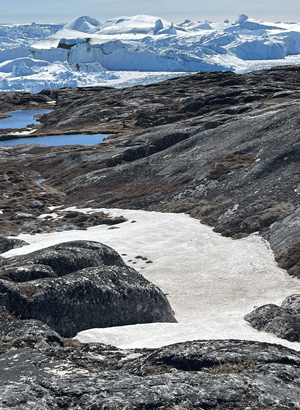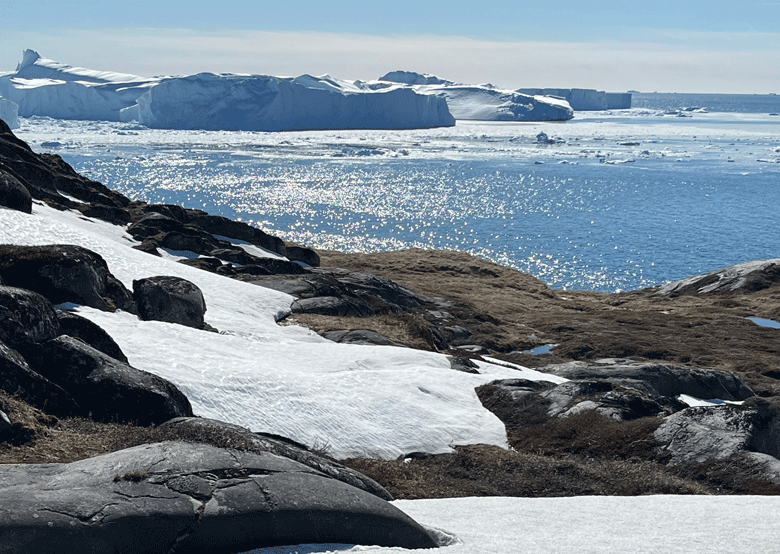I was in Greenland last year and travelled north to south along the western coast from Baffin Strait to the Atlantic Ocean, visiting the four major coastal towns of Illulisat, Sisimuit, Nuuk, and Narsaq/Narsasuaq. We travelled by coastal ferry and by internal air, at low altitude to see what is called “sea ice melt.”
This dissolution of the glaciers that cover most of Greenland was dramatically visible. As one of my traveling companions observed, “It was like looking back in time,” suggestive of glacial melt and retreat in other periods of global warming, beautiful, foreboding, and stark evidence of the source and volume of melt water, sea level rise, and temperature increase, now observable, measurable, and implicative of serious consequence for a future that arrives inexorably every day.
There are additional consequences that have become apparent to me. The first is research studies that reveal that rapid loss of sea ice exposes the sea to the atmosphere, increasing take up of CO2 at a faster rate than elsewhere, and contributing to amplified acidification of ocean water, circulated by natural currents that distribute the consequence worldwide.
Greenland has long been a focal point for potential mineral extraction, especially rare earth metals such as uranium, gold, and zinc.
Given the enormous volume of the ocean, perhaps this seems insignificant, but the studies released by the Polar and Marine Research Institute at Jimei University, China, and the School of Marine Policy at the University of Delaware in the U.S. indicate the amplification measured between 1994 and 2020 shows a change of three to four times that of other ocean basins. This will add to the already critical ocean acidification challenge with increased saturation and negative impact on ocean species, especially plants and coral reefs. We have reached the point when incremental change is critical change and without compensating action to reverse or reduce the CO2 emissions into the atmosphere, we have done nothing but accelerate the problem.
A second consequence pertains to the sediment output of the meltwater flows, the release of cobbles and pebbles and grains of silt, previously frozen into the ice, now descending from the glacial face into ice floes, open streams, coastal deltas, and the open ocean. This phenomenon was dramatically visible from the air.

Greenland has long been a focal point for potential mineral extraction, especially rare earth metals such as uranium, gold, and zinc. Some of the identified sites are in some of the most beautiful and biodiverse areas in the world. Narsaq, the town adjacent to the Kujataa World Heritage Site, is downwind and downstream from a proposed uranium mine that has generated local and national opposition because of air quality and water quality issues, impact on tourism, social consequence of imported workers, and financial consequences of royalty payments and exported profits. The argument revolves around revenue and independence just as it does with proposed deep-sea mining projects adjacent to small island nations in the Pacific.
There is a different option, suggested by the study published in a 2019 issue of Nature Sustainability—taking from the newly revealed coastal sediment deposits of sand and gravel, not rare earth metals, but nevertheless a necessary element in basic road construction and infrastructure rebuilding, in critical demand worldwide, located in the near shore zoneto be mined and pumped by pipeline to offshore dry-bulk carriers by local employees, and traded by Greenland for perhaps comparable revenues.
There are always related problems, of course, specifically to fisheries and tourism, the other two major sources of Greenland’s financial security—the residues from extraction affecting adjacent fishing grounds, for example, or the industrialization of an otherwise wild Arctic coast. We have here again another one of those offsetting choices: to do or to don’t?
Greenland, by its location, has built a community of self-reliance, resilience, and independence. The Inuit population has escaped the worst of colonization, retaining generational strength, language, and cultural traditions.
Demark provides a large percentage of the annual budget, but there is a separate constitution and legislature. Young people typically are educated abroad and many return and are now emerging in leadership positions in government and management.
But still, it is a place apart. There are no roads connecting the towns. Subsistence has been reliant on hunting and fishing, travel by dog sled or small boats. No country on earth is dealing with the impact of global warming, glacial melt, and sea level rise as directly.
There, the implications are facts; the future we envision is now. I felt great hope there, confidence in the people to meet, adapt, and invent a future built on history, values, and community. We could learn so much from our past mistakes, so much from Greenland.
Peter Neill is director of the World Ocean Observatory, which produces weekly radio essays heard on WERU-FM, 89.9, on podcast at apple.com/us/podcast/world-ocean-radio/id425361249, and at www.worldoceanobservatory.org/world-ocean-radio. He lives in Sedgwick.





